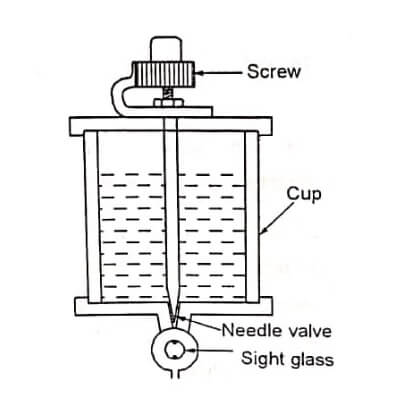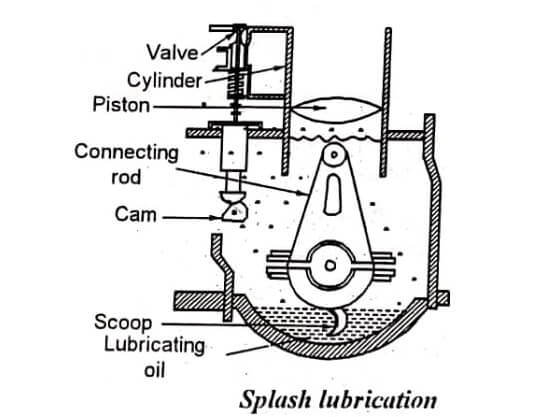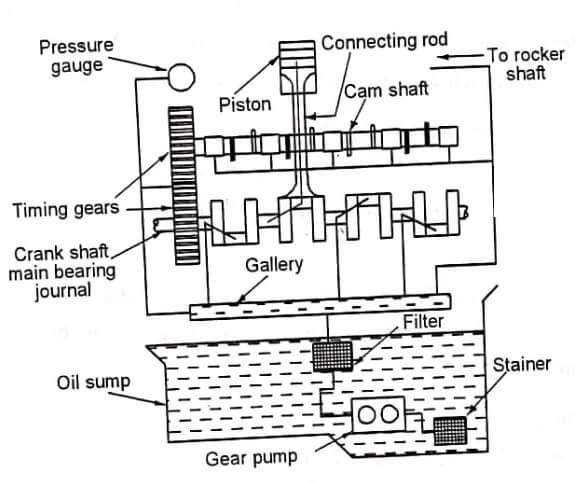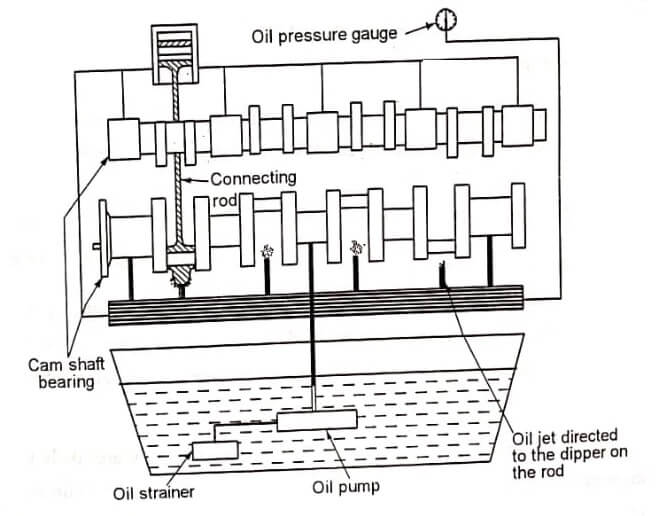In an I.C engine, moving parts rub against each other causing frictional force. Due to the frictional force, heat is generated and the engine parts wear easily. Power is also lost due to friction. To reduce the power loss and also wear and tear of the moving parts, a foreign substance called lubricant is introduced in between the rubbing surfaces. The lubricant keeps the mating surfaces apart. Lubrication system may be solid (graphite), or semi-solid (grease) or liquids (oil). The liquid lubricant generally used is mineral oil. This is obtained by refining petroleum. Grease is also used to lubricate certain parts of the engine.
Purposes of lubrication (or) Functions of lubrication:
- It reduces friction between moving parts.
- It reduces wear and tear of the moving parts.
- It minimizes power loss due to friction.
- It provides cooling effect: During circulation, it carries heat from the hot moving parts and delivers it to the surrounding
through crankcase. - It provides cushion effect:- It serves as a cushion against the shocks of the engine.
- It provides cleaning action:- Impurities such as carbon particles are dissolved during its circulation.
- It provides a sealing action:- It helps the piston rings to provide an effective seal against high pressure gases in the cylinder from leaking out.
- It reduces noise.
Parts of lubrication system
- Internal surface of cylinder walls.
- Crank shaft bearings
- Crank pin
- Camshaft
- Cam shaft bearing
- Valve mechanism
- Piston rings
- Piston pin or gudgeon pin
- Timing gears
- Big end and small end of the connecting rod bearing.
PROPERTIES OF LUBRICANT
The lubricant used in I.C engine should have some properties for the successful performance of the engine. The properties required for a good lubricant are listed below:
Viscosity :
Viscosity is defined as the measure of fluid resistance to flow. Viscosity of the lubricant is depending upon its temperature. Viscosity of lubricant decreases as temperature increases and vice versa. This property is very important property of lubricant because it determines how efficiently the oil film separates the moving surfaces from each other and prevents them rubbing. If high viscosity (i.e. too thick) oil is used, it will lead to power loss, higher operating temperature and excessive wear. If low viscosity oil is used, it cannot lubricate properly and leads to rapid wear of moving parts.
Oilness :
It is the property of an oil to spread and attach itself firmly to the bearing surfaces. In general, high oiliness is required for better lubrication.
Flash point :
Flash point of the lubricant is the temperature at which it forms vapours and produces combustible mixture with air. The high flash point is always desirable because low flash point leads to burning of lubricant. The minimum flash point of lubricating oil used in I.C. engine varies from 200 to 250°C.
Fire point :
The fire point is the lowest temperature at which the fuel burns continuously. Fire point should be higher than the flash point.
Volatility :
When the lubricating oil is exposed to a high temperature for long time, it may evaporate. This property is known as volatility. The lubricating oil should have low volatility.
Pour point :
It is defined as the temperature below which oil will cease to flow in the pipeline under controlled test conditions lubricants having lesser pour point are always recommended as its flow will start even when the engine is started in cold weather.
Delergency :
The lubricating oil should carry away small particles worn out carbon particles) to keep the interior of the engine clean known as delergency.
Neutralisation :
The lubricating oil should be neither acidic nor alkaline otherwise it will have corrosive action on the parts of the engine.
(Ex) Foaming : It is the condition in which minute air bubbles are held in the oil. It will reduce the mass flow and also accurate oxidation. Therefore, the oil should force from foaming trouble.
(x) Emulsification : The lubricating oil should not form an emulsion when brought in contact with water. A good lubricating oil must not emulsify easily.
Methods of Lubrication
The various methods adopted for lubrication of I.C. engines are
- Petroil lubrication or mist lubrication system,
- Wet sump system, and
- Dry sump system.
Petroil or Mist lubrication system :
It is the simplest of all types of lubrication. This method is used in light vehicles such as motor cycles and scooters. About 3 to 6% of lubricating oil is mixed with petrol in the fuel tank. Here, there is no separate sump and pump. The oil mixing with petrol acts as a lubricant.
The disadvantage of this method is, if the engine remains idle for long time, the oil will get separated and cause clogging of fuel passage in carburetor thereby resulting in starting trouble. If the quantity of mixing oil is less, lubrication is insufficient which causes damage to the engine. If the quantity of oil is more, it will release more carbon deposits in the cylinder. So, the engine will give dark smoke.
Wet sump system :
In this method, the lubrication oil is stored in the oil sump. From the oil sump, the oil is supplied to various parts of the engine. This system may be further classified as:
(a) Gravity lubrication system
(b) Splash lubrication system
(c) Pressure lubrication system
(d) Semi-pressure lubrication system
Gravity lubrication System

In this method, oil is supplied to the parts to be lubricated by means of gravity. This system uses a drop feed oiler shown fig. It consists of a cup and needle valve arrangement. The needle valve is operated by means of screw. The valve is raised to increase the flow of oil and lowered to decrease the oil flow. This system is used for lubricating external moving parts such as bearings, cross head, crank pins of simple steam engine.
Splash lubrication system :
In this system, oil is stored in the crank case. A small scoop is attached with the big end of connecting rod as shown in fig.
When the crank is rotated, the scoop dips in the oil and splashes the oil. The oil is splashed on cylinder wall, connecting rod ends and valve mechanisms. This method is used in some motorcycles and single cylinder stationary engines. Greater care should be taken that the oil in the crank case is filled up to the desired mark. There will be insufficient lubrication when the oil level is low.

Disadvantages
- It is not efficient, if the bearing loads are heavy.
- It is very difficult to introduce oil in the minute gaps between the sliding surfaces.
Pressure lubrication system :
In this system, lubricating oil is forced under pressure by a pump at a pressure of 2 to 4Mpa. Fig shows a line diagram of this system. It consists of oil sump, oil pump, oil gallery, pressure release valve, oil filter, oil pressure gauge and oil dipstick. The lubricating oil from the sump or. oil pan is sucked by oil pump and lifted to oil main gallery through oil filter and strainer. The oil pump is driven by the camshaft. Oil pump and filter are always immersed in the oil.
From the oil gallery, the oil is distributed under pressure to various parts of the engine to be lubricated by the oil tubes. Oil from gallery enters the crank pin bearing through a taper hole in the crank shaft. A through hole is provided at the centre of the connecting rod. The oil from the big end bearing enters the gudgeon pin bearing (small end bearing) through the hole in the connecting rod. Separate oil tubes carry oil for lubricating timing gears, rocker arm assembly, cam shaft etc. Another oil line is connected to the pressure gauge to show the pressure of the oil.

The excess supplied oil drips back into the oil sump. A pressure relief valve is provided to avoid any damages in case of excess oil pressure. An oil dipstick is provided to measure the oil level in the sump.
Advantages :
- All the parts of the engine are efficiently lubricated.
- The minute gap between the sliding surfaces can be lubricated since the oil is supplied under pressure.
Engine parts lubricated under pressure: Crank shaft main bearings, cam shaft main bearings, big end bearings of the connecting rod, timing gears, chain and sprocket, rocker arm, springs, valve stems, valve guides etc.
Semi pressure lubrication system :
It is also called as partial pressure lubrication system. This is a modification of splash lubrication system. This system is used if the bearing loads are heavy and splash lubrication is not sufficient. It is a combination of splash and pressure lubrication.
This system consists of oil pump, oil gallery, oil filter, oil pressure gauge and scoops attached to connecting rod big end. The pump pumps the oil to the main gallery. From the gallery, oil is forced under pressure to the engine parts to be lubricated. Scoops or dippers are attached to the big end of the connecting rod.
The lubricating oil is directed to the scoops through oil jets from gallery. The scoops splash this oil in all directions to lubricate the engine parts such as piston, cylinder wall etc.
Engine parts lubricated by splash: Piston, cylinder walls, cams, piston pin and rings, spring and guides of valve stems, oil pump drive gear etc.
Dry sump lubrication system :
The lubricating oil stored in the oil sump is called wet sump system. But the system in which the lubricating oil is not kept in the oil sump is known as dry sump system. In this system, oil is carried in separate tank and fed to the engine.
The oil which falls into the oil sump after lubrication is sent back to the oil tank by a separate delivery pump. Thus the system consists of two pumps. One pump is used to feed the oil. The other pump is used to deliver the oil to the oil tank. This system is used in aircrafts.
The main advantage of this system is that there is no chance of break down in the oil supply during up and down movement of the vehicle.
| Read More Topics |
| Types of bearing and application |
| Diesel engine power plant |
| Evaporative emission control system leak |
| Working principle of a centrifugal pump |






